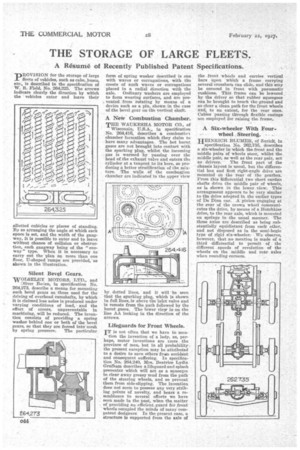THE STORAGE OF LARGE FLEETS.
Page 66

If you've noticed an error in this article please click here to report it so we can fix it.
A Résumé of Recently Published Patent Specifications.
"BOROVISION for the storage of large fleets of vehicles, such as cabs, buses, etc., is described in the specification of W. R. Field, No. 264,325. The arrows indicate clearly the direction by which the vehicles enter and leave their allotted cubicles or places of standing. By so arranging the angle at which each space is set, and the width of the gangway, it is possible to enter and to leave without chance of collision or obstruction, each gangway being of the " oneway " type. When it is necessary to carry out the plan on more than one floor, TI-shaped ramps are provided, as shown in the illustration.
Silent Bevel Gears.
WOLSELEY MOTORS, LTD., and Oliver Bo'ien, in specification No. 264,273, describe a means for mounting such bevel gears as those used for the driving of overhead camshafts, by which it is claimed less noise is produced under varying conditions of load, and the effect of errors, unpreventable in machining, will be reduced. The invention consists of providing a spring washer behind one or both of the bevel gears, so that they are forced into mesh by spring pressure. The particular form of spring washer described is one with waves or corrugations, with the crests of such waves or corrugations placed in a radial direction with the axle. Ordinary washers are employed to form wearing surfaces, and are prevented from rotating by means of a device such as a pin, shown in the case of the bevel gear on the vertical shaft.
A New Combustion Chamber.
THE WAUKESHA MOTOR CO., of Wisconsin, U.S.A., in specification No. 264,416, describes a combustial chamber formation which they claim to have many advantages. The hot burnt gases are not brought into contact with the sparking plug, whilst the incoming gas is warmed by passing over the head of the exhaust valve and enters the cylinder at a tangent to its bore, so producing a better stratification of the mixture. The walls of the combustion chamber are indicated in the .upper view
by dotted lines, and it will be seen that the sparking plug, which is shown in full lines, is above the inlet valve and is remote from the path followed by the burnt gases. The lower vielv le on the line AA looking in the direction of the arrows.
Lifeguards for Front Wheels.
IT is not often that we have to men
tion the invention of a lady, as, perhaps, motor inventions are more the province of men, but in all probability the present exception may be attributed to a desire to save others from accident and consequent suffering. In specification No. 264,240, Mrs. Beatrice Lydia Grafbam describes a lifeguard and splash preventer which will act as a squeegee to clear away greasy mud from the path of the steering wheels, and so prevent them from side-slipping. The invention does not seem to possess any very striking points of novelty, and bears a resemblance to several efforts we have seen made in the past, when the matter of providing an efficient guard for front wheels occupied the minds of many competent designers. In the present case, a structure is supported from the axle of the front wheels and carries vertical bars upon which a frame carrying several crossbars can slide, and this may be covered in front wah pneumatic cushions. This frame can be lowered by the driver so that rubber squeegees can be brought to touch the ground and so clear a clean path for the front wheels and, to an extent, for the rear ones. Cables passing through flexible casings • are employed for raising the frame.
A Six-wheeler With Four -. wheel . Steering.
HEINRICH BLUMER, of Zurich, in specification No. 262,735, describes a six-wheeler in which the front and the middle pairs of wheels steer, whilst the middle pair, as well as the rear pair, act as drivers. The front part of the chassis layout is usual, but the differential box and first right-angle drive are mounted on the rear of the gearbox. From this liifferentiai two short cardan shafts drive the middle pair of wheels, as is shown in the lower view. This arrangement appears to be very similar to the drive adopted in the earlier types of De Dion car. A pinion engaging at the rear of the crown wheel communicates the drive, by means of a Hotchkiss drive, to the rear axle, which is mounted on springs in the usual manner. The three axles are described as being substantially equidistant from each other, and not disposed as in the semi-bogie type of rigid six-wheeler. We observe, however, that no mention is made of a third differential to permit of the different speeds of revolution of the wheels on the middle and rear axles when rounding corners.












































































































